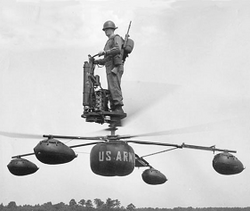De Lackner HZ-1
| De Lackner HZ-1 | |
|---|---|
 HZ-1 in flight |
|
| Type: | Micro helicopter |
| Design country: | |
| Manufacturer: | |
| First flight: |
January 1955 |
| Number of pieces: |
12 |
The de Lackner HZ-1 Aerocycle was a vertical take-off and landing aircraft made by the US manufacturer de Lackner Helicopters Inc. from the Cold War era . On the future, also nuclear battlefield, the HZ-1 was to become the personal aircraft for every soldier. According to the training schedule, a soldier should be able to learn to control the device within 20 minutes. Because of the two open rotors in the immediate vicinity of the body, soldiers sarcastically referred to the device as a “meat grinder” or Fubar construction.
designation
The device was originally named "DH-4 Heli-Vector" by the manufacturer and was first designated as YHO-2 and then as "HZ-1 Aerocycle" during testing by the US Army (see also the designation system for aircraft of the US Army from 1956 to 1962 ). The further development, equipped with a pipe landing gear instead of air bags, was given the factory designation DH-5.
history
development
In the early 1950s, Charles H. Zimmerman developed a control system for aircraft with rotors arranged on the underside at NACA . Control was carried out by simply shifting your weight in the desired direction of flight, also known as kinesthetic control . The speed control of the motor was designed like a motorcycle with a simple throttle grip. Based on this concept, Bensen Aircraft , Hiller Aircraft and de Lackner started their own developments.
De Lackner's proposal was a one-man flying platform that, in addition to the pilot, should carry up to 54 kg and with a fuel supply of five US gallons should achieve a range of 50 km. The idea was to use this flying platform to create a modern version of the cavalry that could offer the fighting army airborne “eyes and ears”.
The United States Army expected to receive an easy-to-fly reconnaissance aircraft from the HZ-1. The early flight attempts certainly gave hope, but the more extensive testing showed that simple soldiers with rapid flight training were unable to handle the controls. Twelve copies ordered by the US Army had serial numbers 56-6928 through 56-6939.
testing
The prototype made its first flight, still tied, on November 22, 1954. The first free flight took place in January 1955. A total of 160 flights with a total duration of over 15 hours were carried out.
In 1956 the testing was moved to Fort Eustis in Virginia, where Captain Selmer Sundby continued the test flights. The HZ-1 turned out to be the fastest of the similar flight platforms commissioned by the US Army. However, Sundby quickly realized that the vehicle was far more difficult to fly than originally thought and could not be safely flown in the hands of an inexperienced soldier. In addition, the low-lying rotors tended to suck in objects from the ground and toss them up.
In the course of the test series with tied and free hovering flights of up to 43 minutes, the HZ-1 suffered two accidents. In both, the cause was that the two coaxial rotors touched each other and the blades were destroyed. Aerodynamic studies in the large wind tunnel of the Langley Research Center showed that the aircraft can nod into uncontrollable pitching movements when flying forward. However, the actual reason for the rotor contact could not be found, so that the project was finally abandoned, not least because of the unfulfilled expectations of this type of aircraft.
construction
The HZ-1 is a one-man mini helicopter in which the pilot stands on a frame under which there are two counter-rotating coaxial rotors, each 4.50 m in diameter, which are driven by a "Kiekhaefer Mercury Mark 55" two-stroke engine via a chain. The landing gear initially consisted of air-filled bags at the ends of the frame and a larger bag in the middle, but was later replaced by a tubular construction. The rotor drive has an automatic compensation of the torque deviations between the rotors and a clutch to enable the autorotation.
Whereabouts
Of the twelve copies built, one can still be seen in the US Army Transportation Museum in Fort Eustis .
See also
literature
- Leonard Bridgman (ed.): Jane's All The World's Aircraft - 1959-60 , Sampson Low, Marston & Company Ltd., London, 1959, pp. 283 f.
Web links
- Description on hiller.org (accessed January 6, 2013)
- Exhibited HZ-1 in the US Army Transportation Museum (accessed January 6, 2013)
- "The Sky-High Invention" including a description of the control system on howtoadvice.com (accessed on January 6, 2013)
- Film from the “Paramount News” with a flight demonstration of the HZ-1 on youtube.com
Individual evidence
- ^ Leonard Bridgman (ed.): Jane's All The World's Aircraft - 1959-60 , Sampson Low, Marston & Company Ltd., London, 1959, p. 283
- ↑ HZ-1 Aero Cycle, USA, 1955
- ↑ John M. Andrade: US Military Aircraft Designations and Serials , Midland Counties Publ., 1979, p. 128

